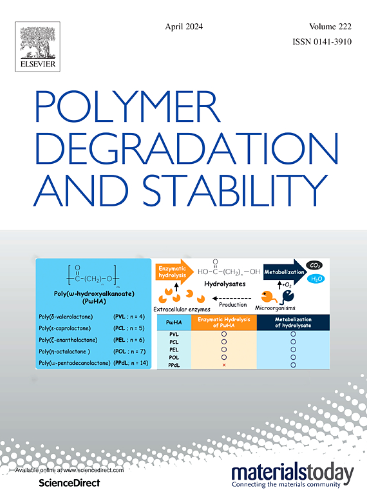为可持续热熔胶设计可生物降解共聚聚酯的规则性:粘附性、可移除性和生物降解性
IF 6.3
2区 化学
Q1 POLYMER SCIENCE
引用次数: 0
摘要
最近,作为传统商用热熔胶的替代品,生态友好型热熔胶的研究有所增加。然而,这种粘合剂在可去除性和生物降解性方面一直存在局限性。本研究通过为单一聚合物设计一种新型分子结构来解决这些问题,从而开发出一种可持续热熔粘合剂,这种粘合剂具有粘合力强、可清除性好、生物降解性高等特点,而且无需额外添加添加剂。通过在聚合过程中改变醇类单体 1,4 丁二醇(BD)和乙二醇(EG)的比例,我们合成了具有四个嵌段的聚(己二酸丁二醇酯-对苯二甲酸丁二醇酯-己二酸乙二醇酯-对苯二甲酸乙二醇酯)(PBEAT)。我们通过降低分子结构的规则性、控制结晶行为和抑制聚合物链的堆积,延长了开放时间。通过改善与粘合剂的润湿性,我们实现了 3.18 兆帕的搭接剪切粘合强度。此外,我们还根据嵌段共聚物的结晶温度(Tc)与剪切粘附失效温度(SAFT)之间的相关性提出了一种脱粘机制,证明了所制备热熔粘合剂的可去除性。最后,在堆肥中进行的水解、酶降解和生物降解分析证实,结晶度降低可提高生物降解性。PBE30AT 具有最强的粘附强度,在堆肥中 20 天内就能完全降解,比纯聚(己二酸丁二醇酯-共对苯二甲酸酯)(PBAT)更快。这项研究提供了一种新颖实用的方法,通过调整聚合物的分子结构来增强可持续粘合剂的潜力和可扩展性。本文章由计算机程序翻译,如有差异,请以英文原文为准。
Designing the regularity of biodegradable copolyester for sustainable hot-melt adhesives: Adhesion, removability, and biodegradability
Recent research has increased in eco-friendly hot-melt adhesives as alternatives to conventional commercial hot-melt adhesives. However, there have been limitations in terms of removability and biodegradability. This study addresses these issues by designing a novel molecular structure for a single polymer, resulting in a sustainable hot-melt adhesive that offers strong adhesion, clear removability, and high biodegradability without additional additives. By varying the ratio of alcohol monomers 1,4-butanediol (BD) and ethylene glycol (EG) during polymerization, we synthesized poly(butylene adipate-co-butylene terephthalate-co-ethylene adipate-co-ethylene terephthalate) (PBEAT) with four block segments. We increased the open time by reducing the regularity of the molecular structure, controlling crystallization behavior, and inhibiting polymer chain packing. This improvement in wettability with the adherend allowed us to achieve a lap shear adhesion strength of 3.18 MPa. Additionally, we proposed a debonding mechanism based on the correlation between the crystallization temperature (Tc) block copolymer's and shear adhesion failure temperature (SAFT), demonstrating the removability of the prepared hot-melt adhesive. Finally, analyses of hydrolysis, enzymatic degradation, and biodegradation in compost confirmed that reduced crystallinity enhances biodegradability. PBE30AT, exhibiting the strongest adhesion strength, achieves complete degradation in compost within 20 days, faster than neat poly(butylene adipate-co-terephthalate) (PBAT). This research offers a novel and practical approach to enhancing the potential and expandability of sustainable adhesives by tailoring the molecular structure of the polymer.
求助全文
通过发布文献求助,成功后即可免费获取论文全文。
去求助
来源期刊

Polymer Degradation and Stability
化学-高分子科学
CiteScore
10.10
自引率
10.20%
发文量
325
审稿时长
23 days
期刊介绍:
Polymer Degradation and Stability deals with the degradation reactions and their control which are a major preoccupation of practitioners of the many and diverse aspects of modern polymer technology.
Deteriorative reactions occur during processing, when polymers are subjected to heat, oxygen and mechanical stress, and during the useful life of the materials when oxygen and sunlight are the most important degradative agencies. In more specialised applications, degradation may be induced by high energy radiation, ozone, atmospheric pollutants, mechanical stress, biological action, hydrolysis and many other influences. The mechanisms of these reactions and stabilisation processes must be understood if the technology and application of polymers are to continue to advance. The reporting of investigations of this kind is therefore a major function of this journal.
However there are also new developments in polymer technology in which degradation processes find positive applications. For example, photodegradable plastics are now available, the recycling of polymeric products will become increasingly important, degradation and combustion studies are involved in the definition of the fire hazards which are associated with polymeric materials and the microelectronics industry is vitally dependent upon polymer degradation in the manufacture of its circuitry. Polymer properties may also be improved by processes like curing and grafting, the chemistry of which can be closely related to that which causes physical deterioration in other circumstances.
 求助内容:
求助内容: 应助结果提醒方式:
应助结果提醒方式:


